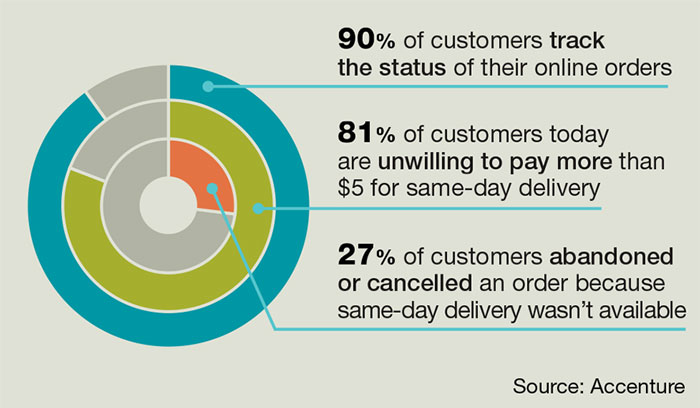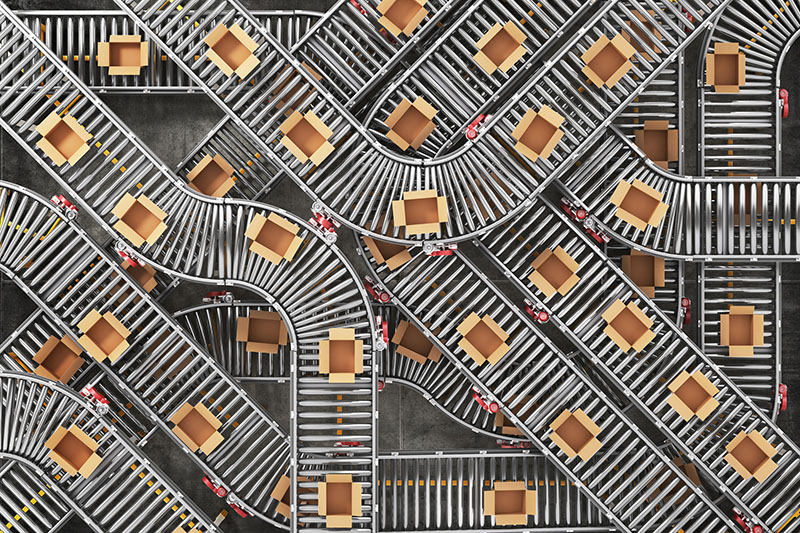Customers Satisfied: What the future of fulfillment looks like
The six building blocks of customer-centric fulfillment.
Today, a company’s product is no longer the sole driver of value. The experience a customer gets from the combination of products and services is now what sets companies apart.
That’s where supply chain comes in: It can be “one-size-fits-all” and under-serve segments while over-serving others, or it can actually enrich the customer experience and enable new ways of fulfilling demand while aligning to new buyer values such as responsible business practices and sustainable sourcing of materials.
To do this, supply chains must be able to deeply understand customers, anticipate and shape their short- and long-term needs, and engage each customer or customer segment with different service levels.
In other words, an intelligent, customer-centric supply chain that transforms companies’ management, distribution and transportation is needed, especially with COVID-19 rewriting the rules for how people shop today—a new reality that’s putting massive strain on existing supply chains.
We’ve outlined the six building blocks critical for the creation of customer-centric fulfillment:
Living segmentation. It all starts with segmentation. With customers increasingly demanding more personalized experiences, one-size-fits-all fulfillment has become an impediment to growth. Instead, companies need to segment their fulfillment infrastructure to effectively balance customer service levels and cost—considering product flow and demand in relation to volume and variability.
Importantly, this segmentation must be “living.” Over time, the combination of product, customer, channel and geography may move through different segments based on their volume and service level needs.
Thus, companies need to understand the service level requirements for each segment and be able to tailor fulfillment capabilities—especially, the number, size and location of warehouses and transportation modes and carriers—accordingly on a yearly, quarterly or even monthly basis.
Asset-light operations. A highly-segmented fulfillment infrastructure is inherently more complex than a single, mass-focused one. Because of this complexity, it can be very difficult and expensive for one company to build that infrastructure and to also meet the growing importance of responsible business goals that minimize the negative impact to the environment.
That’s why companies should partner with other entities for certain warehousing and transportation capabilities that make more sense being provided by third parties. In addition to reducing complexity and cost, such an “asset-light” approach to fulfillment provides greater flexibility for a company to scale up or down quickly in conjunction with market conditions and customer demand and drives synergies of infrastructure utilization that can have an improved environmental impact.
Sharing warehousing across multiple companies could come into play in the coming years, especially given the anticipated increase in demand for warehouse space. With the surge in e-commerce expected to have legs, the U.S. alone is projected to need 1
billion square feet of warehouse space by 2025.
Real-time visibility. When fulfillment breaks down, it’s often because a company lacks visibility into its network. Being able to see fulfillment from end-to-end, in real time, is critical to ensuring orders get delivered to the right customer, at the right time and at the right cost.
Without understanding exactly what’s on each truck and to which customers those goods are being sent, a company doesn’t have what it needs to confirm an order is on track to be filled accurately and on time—or, more important, act decisively when something goes amiss in the order fulfillment process. This visibility must extend to inventory across every node in the network whether it’s a truck, warehouse or customer site.
The fact is, when considering omni-channel fulfillment, everything starts with inventory—knowing in real time, or near-real time, precisely where everything is, both at rest and in motion, and what segment and ultimate customer that inventory is earmarked to serve. Key technology ecosystem partners can provide the tools and platforms that can help companies quickly and inexpensively build the capabilities needed to generate this all-important visibility.
Service-oriented operating model. Most supply chains today are plagued by varying degrees of “siloization,” meaning that there are different business units, brands, or affiliates with their own fulfillment organization and, many times, their own tools, technologies, processes, and structures.
These entities typically operate largely independent of each other and optimize their own performance, which is the antithesis of what’s needed to be truly customer centric. That’s where a service-oriented operating model comes in.
The concept is simple: Based on the segmentation strategy’s needs, certain areas are better served by a consistent set of skills and capabilities that can be leveraged across multiple parts of the business. This approach has proven to be beneficial for areas such as order management, but also can be applied to other areas of fulfillment.
Data, applied intelligence and technology. Core to visibility and intelligent decisions is data. Without the right data, companies are flying blind and operate with inaccurate or incomplete information, which means they can’t consistently serve any customers well.
As companies move toward more customer-centric fulfillment, they’ll be using data as never before. They’ll apply artificial intelligence and machine learning to their rich cache of data to automate increasingly large swaths of fulfillment beyond the robots many already employ in their warehouses, using computers to complete tasks that today are still largely handled by humans.
As machines handle more of these transactional tasks, people will manage largely by exception. Instead of physically performing those functions, the workforce will pivot to tweaking and tuning the algorithms in the models, and optimizing the engine, to execute tasks.
They’ll spend most of their time creating the various response scenarios to events that happen and codifying them into the algorithms so responses can happen automatically with little to no human intervention.
Additionally, fast maturing technologies in automation, autonomous vehicles, alternate energy, sustainable infrastructure and building materials are all driving significant changes in the fulfillment space.
These technologies, combined with the utilization of advanced data sciences, are evolving warehousing and transportation capabilities to a more automated, responsive, and responsible infrastructure that will continue to evolve faster and faster.

Continuous innovation. Ongoing, often rapid changes in customer needs, competition and technology mean companies can’t afford to stand still. That’s why to remain customer-centric, fulfillment must be driven by a continuous innovation mindset that enables a company to quickly accommodate new technologies, ecosystem partners, and processes so fulfillment can respond to what customers want in any given moment.
That’s especially true as the complexity involved in precisely meeting customer expectations most cost-effectively will only increase in the coming years. And that’s the beauty of the asset-light, flexible model.
Today, many companies are married to big legacy systems and third-party logistics providers with which they have longstanding relationships. Moving away from these carriers creates risks in both cost and reputation, so companies feel they’re forced to live with their current situation.
With an asset-light model, the “barriers of exit” are low. It’s easy to swap out applications and delivery partners for others when needed, making continuous innovation of fulfillment possible.
What’s next?
With new customer demands increasing, supply chain needs to improve with new capabilities and infrastructure critical to meeting those expectations. These six building blocks serve as the foundation for transformation, but incorporating them into the business might seem overwhelming if thought of as one massive change.
For companies that want to adapt, a continuous evolution is the best way forward. First, set the North Star—the vision for fulfillment—then create a multi-year road map around 10- to 12-week sprints to get there.
This is not a “problem to be solved” with a big project—those days are gone. The ever-changing customer, competitive and technology landscape requires an agile approach to change, with an equally flexible road map that can continuously evolve as needed.

Article Topics
E-commerce News & Resources
Solving the last-mile delivery issue in New York City UPS is set to take over USPS air cargo contract from FedEx UPS presents updated financial goals and strategic targets at its investor day FedEx fiscal third quarter earnings see gains amid ongoing volume declines National Retail Federation 2024 retail sales forecast calls for growth Will recent talks between FedEx and Amazon lead to a reunion? February retail sales see gains, reports Commerce and NRF More E-commerceLatest in Logistics
LM Podcast Series: Assessing the freight transportation and logistics markets with Tom Nightingale, AFS Logistics Investor expectations continue to influence supply chain decision-making The Next Big Steps in Supply Chain Digitalization Warehouse/DC Automation & Technology: Time to gain a competitive advantage The Ultimate WMS Checklist: Find the Perfect Fit Under-21 driver pilot program a bust with fleets as FMCSA seeks changes Diesel back over $4 a gallon; Mideast tensions, other worries cited More LogisticsSubscribe to Logistics Management Magazine

Find out what the world's most innovative companies are doing to improve productivity in their plants and distribution centers.
Start your FREE subscription today.
April 2023 Logistics Management

Latest Resources
















